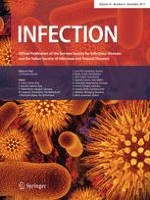Erschienen in:

05.10.2017 | Original Paper
Performance of automated multiplex PCR using sonication fluid for diagnosis of periprosthetic joint infection: a prospective cohort
verfasst von:
Nora Renz, Susanne Feihl, Sabrina Cabric, Andrej Trampuz
Erschienen in:
Infection
|
Ausgabe 6/2017
Einloggen, um Zugang zu erhalten
Abstract
Purpose
Sonication of explanted prostheses improved the microbiological diagnosis of periprosthetic joint infections (PJI). We evaluated the performance of automated multiplex polymerase chain reaction (PCR) using sonication fluid for the microbiological diagnosis of PJI.
Methods
In a prospective cohort using uniform definition criteria for PJI, explanted joint prostheses were investigated by sonication and the resulting sonication fluid was analyzed by culture and multiplex PCR. McNemar’s Chi-squared test was used to compare the performance of diagnostic tests.
Results
Among 111 patients, PJI was diagnosed in 78 (70%) and aseptic failure in 33 (30%). For the diagnosis of PJI, the sensitivity and specificity of periprosthetic tissue culture was 51 and 100%, of sonication fluid culture 58 and 100%, and of sonication fluid PCR 51 and 94%, respectively. Among 70 microorganisms, periprosthetic tissue culture grew 52 (74%), sonication fluid culture grew 50 (71%) and sonication fluid PCR detected 37 pathogens (53%). If only organisms are considered, for which primers are included in the test panel, PCR detected 37 of 58 pathogens (64%). The sonication fluid PCR missed 19 pathogens (predominantly oral streptococci and anaerobes), whereas 7 additional microorganisms were detected only by PCR (including Cutibacterium spp. and coagulase-negative staphylococci).
Conclusions
The performance of multiplex PCR using sonication fluid is comparable to culture of periprosthetic tissue or sonication fluid. The advantages of PCR are short processing time (< 5 h) and fully automated procedure. However, culture technique is still needed due to the low sensitivity and the need of comprehensive susceptibility testing. Modification of primers or inclusion of additional ones may improve the performance of PCR, especially of low-virulent organisms.